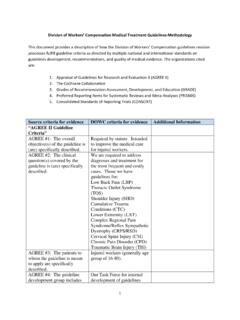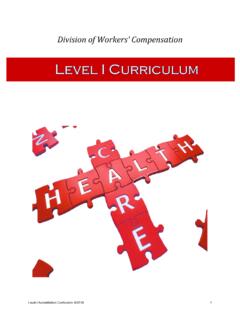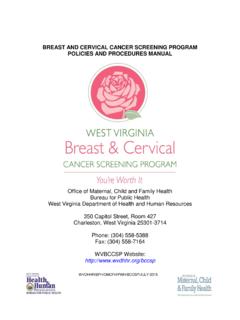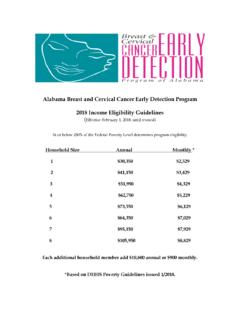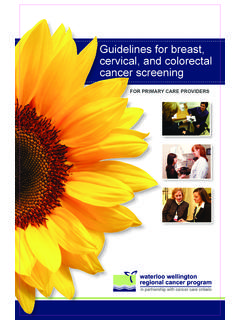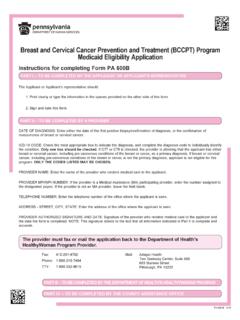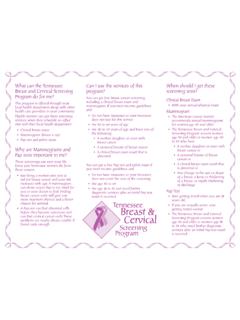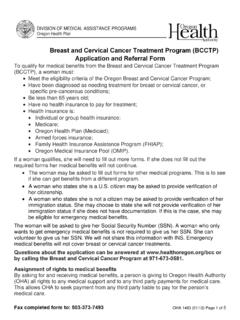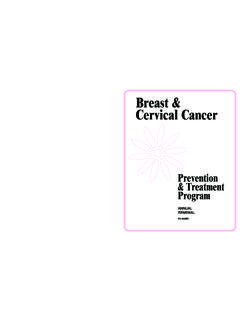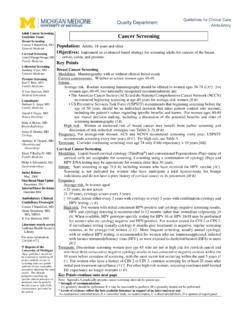Transcription of Health First Colorado’s Breast and Cervical Cancer Program ...
1 Women s Wellness Connection Toolkit 11/2016 Breast Cancer Screening Guidelines .. 2 1. Breast Health History .. 2 2. Breast Health Education .. 2 3. Clinical Breast Exams .. 3 4. Annual Breast Health / Breast Education Visit .. 3 5. Screening Mammography .. 3 6. Breast Diagnostics and Management of Abnormal Breast Findings .. 5 7. Health First Colorado s Breast and Cervical Cancer Program (BCCP)) for the Treatment of Eligible Diagnoses .. 7 References .. 8 Cervical Cancer Screening Guidelines .. 8 1. Cervical Health History .. 8 2. Cervical Health Education .. 8 3. Pelvic Exams .. 9 4. Screening for Cervical Cancer .. 9 5. Management and Follow-Up of Abnormal Cervical Cancer Screening .. 11 6. Health First Colorado s BCCP for the Treatment of Eligible Diagnoses .. 12 References .. 12 Tobacco Use Assessment and Referral Policy .. 13 Background .. 13 Assessment of Tobacco Use Status .. 13 QuitLine Referral Process .. 14 For the Client Unready to Quit.
2 14 Marijuana Resources .. 14 Transgender Coverage .. 14 Transgender Resources (National) .. 15 Colorado Transgender Resources .. 15 Women s Wellness Connection Toolkit 11/2016 Clinical services under the Women s Wellness Connection (WWC) Program may be carried out by a WWC agency or through subcontracts with other agencies. However, a WWC agency must perform basic Breast and Cervical Cancer screening services on-site. Basic screening services include Breast and Cervical Health history assessment, Breast and Cervical Health education, clinical Breast exams, pelvic exams and Pap tests. These services are covered in more detail below. A WWC agency must be the agency ultimately responsible for the care and follow-up of the clients it enrolls in the WWC Program . In other words, each agency must own and manage the clients it enrolls in WWC. WWC clinical policies are not intended to limit client care or interfere with clinical decision-making of individual providers.
3 However, agencies must adhere to WWC clinical policies in order to ensure appropriate use of Program funding and procedure reimbursement for WWC enrolled clients. Provider discretion may be used to provide services beyond the WWC clinical policies, but WWC is not able to reimburse for these services. WWC Breast Cancer screening guidelines are based on nationally recognized clinical guidelines from organizations such as the Preventive Services Task Force (USPSTF), American College of Obstetricians and Gynecologists (ACOG), National Cancer Institute (NCI), American Cancer Society (ACS), and with advice from the WWC medical director and Medical Advisory Board. National guidelines and recommendations do not replace clinical judgment based on individual circumstances of the client. A Breast Health history must be recorded in the client s chart. Breast Health history should include, at a minimum, questions about: Personal history of Breast Cancer .
4 First degree relative with Breast Cancer ( mother/father, sister/brother, daughter/son). New Breast symptoms during the past three months. Collecting a comprehensive family history to assess for Breast Cancer risk is highly encouraged. This may include family history of prostate Cancer , ovarian Cancer , and BRCA1 or 2 gene mutations). Breast Health education must be provided and documented in the client s chart and eCaST if the agency wishes to receive reimbursement for Breast services that do not go beyond level B1 of the Bundled Payment System (BPS) and do not include a clinical Breast exam (See the Reimbursement section). Education must be provided in the context of an office visit. Education may be provided by the provider or other trained staff to the client in verbal or written form. Breast Health education should include, at a minimum, information about: Breast Cancer screening intervals. Women s Wellness Connection Toolkit 11/2016 The risks and benefits of mammogram screening.
5 Risk factors for developing Breast Cancer . Symptoms of Breast Cancer . How to reduce risk of Breast Cancer (stay physically active with regular exercise; maintain a healthy weight; limit use of combination (estrogen + progesterone) hormone therapy, or know the risks and benefits of HRT and if it is the right option for the client; and limit the amount of alcohol consumed). NBCCEDP s Breast Cancer Facts client handout can be used to meet this education requirement. This handout can be found here: A clinical Breast exam (CBE) may be provided yearly at the discretion of the provider. Yearly CBEs are considered optional by WWC and may be performed based on the provider s and the client s determination of need. Performance of a CBE is not required to receive reimbursement for Breast Cancer screening services. However, an office visit is required. Agencies may be reimbursed for returning clients, who have an office visit and are determined by a mid-level, or higher, provider to not need a Breast screening after review of the client s Health history, who have a visit that includes Breast Health history and education.
6 Breast Health history and education (as detailed in #1 and 2 above) must be completed and documented in the chart and eCaST in order to receive reimbursement in absence of a Breast procedure ( CBE/mammogram). WWC follows the United States Preventive Services Task Force (USPSTF) recommendations. Although USPSTF recommends (Grade B) biennial screening, annual screening mammograms are covered for clients age 50-64 years in WWC. Annual screening is defined as 10 months or greater from the initial or previous screening. WWC covers targeted screening mammograms for clients ages 40-49. In order to be compliant with USPSTF guidelines, providers must avoid offering routine screening in this age group and instead, discuss potential benefits and harms of mammography screening in order to assist clients in making an informed choice. Women who place a higher value on the potential benefit than the potential harms may choose to begin screening between the ages of 40 and 49 years (USPSTF Grade C recommendation).
7 O Counseling prior to scheduling a screening mammogram for a client ages 40-49 should consist of a detailed conversation and agreement between a Women s Wellness Connection Toolkit 11/2016 clinical staff member and client that includes discussion of benefits and harms of screenings, a client s preference and Breast Cancer risk profile. Clinical staff may use the WWC Targeted Screening Client Handout found on the WWC website to provide this counseling. This counseling is more detailed and specific than the typical Breast Health education (described in #1, above). However, the more detailed counseling described here will also meet the requirements of the Breast Health education. o The counseling should include specific information regarding: 1) Risks, including: false-positive and false-negative rates, rates of additional diagnostics, the detection of tumors that may not progress to Cancer , anxiety/discomfort, and over diagnosis ( , tumors detected on screening that never would have led to clinical symptoms).
8 2) Benefits, including: a decreased risk in Breast Cancer mortality and if diagnosed with Breast Cancer , the need for less aggressive treatment. o Some women with no family history of Breast Cancer will elect to wait until age 50 to start screening mammography; others may not be comfortable doing so. WWC encourages agencies to utilize one or more of the following three tools to assist providers and clients in determining whether a client 40-49 years old is an appropriate candidate for a screening mammogram. 1) The USPSTF recommendations on Shared Decision-making About Screening and Chemoprevention. 2) The National Cancer Institute s Breast Cancer Risk Assessment Tool. Women s Wellness Connection Toolkit 11/2016 3) WWC s quick reference table Reasons a 40-49 year old client may be recommended to have a screening mammogram Reasons a 40-49 year old client may not be recommended to have a screening mammogram Personal history of Breast Cancer .
9 Family history of Breast Cancer . Previous Breast biopsy. Known genetic mutations. Unknown family history. Excessive alcohol use, defined as 2 or more drinks daily. Ashkenazi Jewish decent. Nulliparity (never had children). First child born after the age of 30. Breast density noted on previous mammogram of 51% or higher. History of chest mantle radiation for Hodgkin Lymphoma or non-Hodgkin Lymphoma. Has no identifiable factors for increased risk. Hesitant about the possible harms of screening mammography. Feels the possible harms are greater than the benefits in her case. Meeting the Centers for Disease Control and Prevention s Screening Core Performance Indicator for mammograms (at least 75 percent of all mammograms performed should be provided to clients who are 50 years of age and older) continues to be a priority of the WWC Program . Recruitment efforts should continue to be focused on this priority population.
10 Breast Ultrasound or Automated Whole Breast Ultrasound is not covered by WWC when used as a screening method. 3D tomography (tomosynthesis) is not a covered screening procedure under WWC (USPSTF Grade I recommendation). Breast diagnostic services are covered for all clients eligible for WWC if they have Breast symptoms, abnormal CBEs, abnormal screening mammograms, or referrals for diagnostic work-ups. Requirements for Management of Abnormal Breast Exams or Imaging Results: The 2011 Breast Cancer Diagnostic Algorithms for Primary Care Providers (4th Ed.) must be used by WWC agencies to guide clinical decision-making in the work-up of Breast abnormalities. These algorithms may also be used to assess risk of Breast Cancer . Also included in the algorithms are clinical tools including core competencies of a clinical Breast exam, CBE results documentation form, and a Breast Cancer history and risk assessment client information form.
